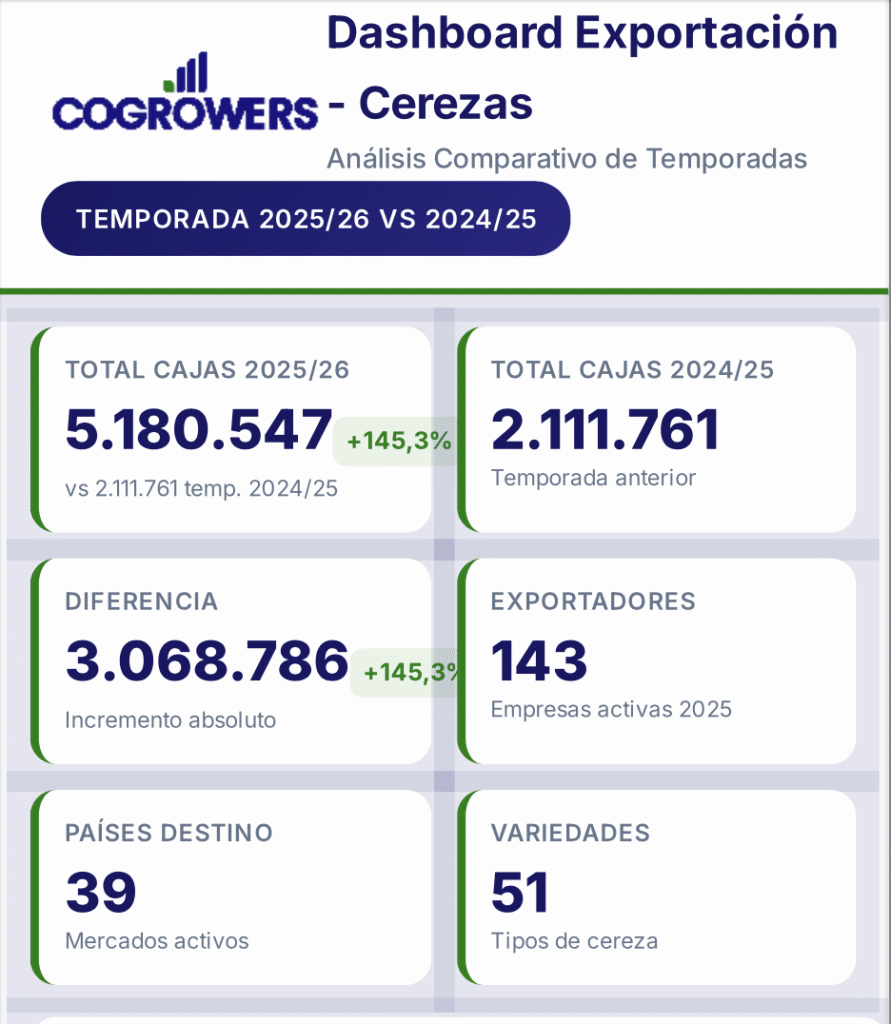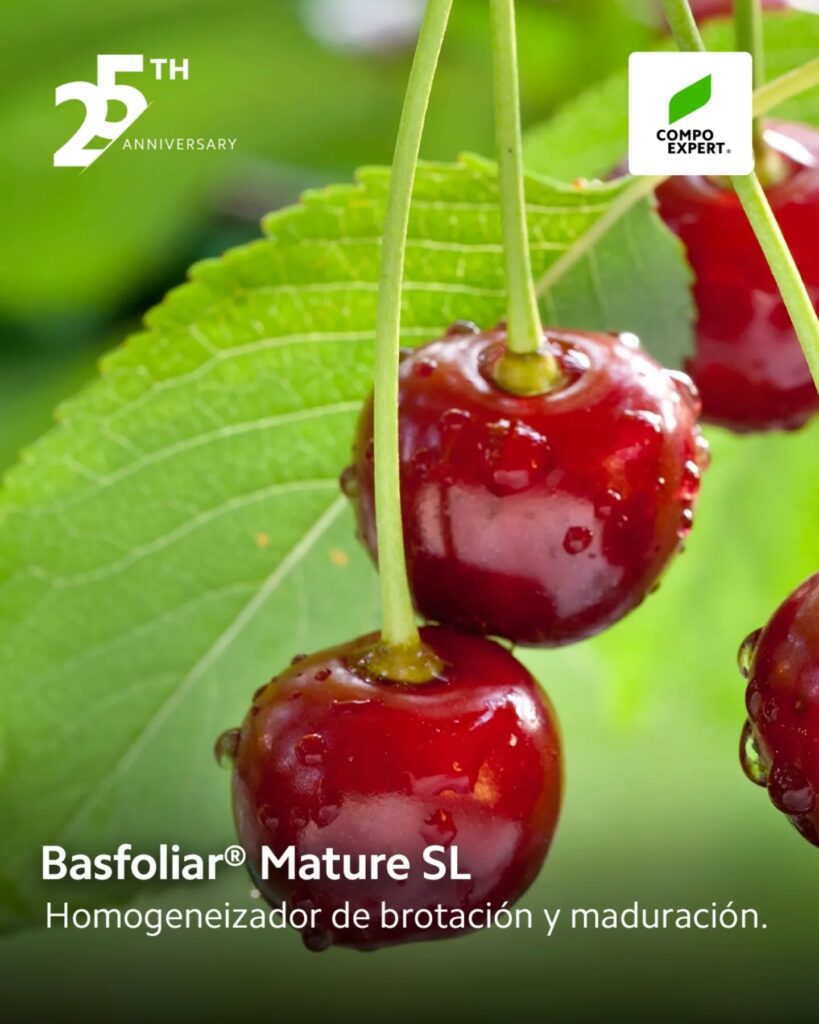By Francisca Barros B, Jessica Rodríguez F, Militza Ivelic K/ Trío Kimün.
The selection of the variety is one of the most important decisions when planting a cherry orchard. In addition to technical-productive, economic and strategic considerations, its post-harvest performance must be known.
Among the main attributes expected from cherry varieties for export are productive attributes such as: high yield, large fruit (sizes greater than 28 mm), smooth and shiny skin, ideally self-fertile and early. On the other hand, organoleptic attributes and good storage behaviour are sought.
Among the organoleptic attributes, the Asian market (main destination market) seeks fruit with flavour, for which it must have sweet fruit (high soluble solids), with balanced acidity, firm (over 75DU= Durofel Units) and crunchy. As for storage behavior, fruit resistant to damage from cracking and pitting is sought. In addition to these visual characteristics, its internal condition must allow for prolonged storage, considering that it must travel, mainly by sea, for periods of no less than three weeks, also considering the period until consumption.
The range of cherry varieties in our country in recent years has been essentially focused on 5 varieties, which have varied in importance ranking. Last season (2019-20) this group of varieties accounted for 82% of the exported volume (Table 1).
In the last season, the Lapins variety was the most exported variety, representing 31% of the total, followed by Santina (18%), Regina and Bing, each representing approximately 13%, and Sweetheart with 7%.
Table 1. Comparative volume of exported cherries by variety and season
| Varieties | 2018/19 | 2019/20 | % total |
| Lapins | 51.521 | 71.190 | 31,15 |
| Santina | 29.359 | 41.450 | 18,14 |
| Regina | 19.948 | 30.676 | 13,42 |
| Bing | 33.398 | 29.476 | 12,90 |
| Sweetheart | 14.804 | 16.216 | 7,10 |
| Royal Dawn | 7.511 | 12.332 | 5,40 |
| Kordia | 4.777 | 5.039 | 2,20 |
| Skeena | 2.282 | 4.143 | 1,81 |
| Rainier | 2.558 | 2.642 | 1,16 |
| Other varieties | 13.770 | 15.384 | 6,73 |
| Total | 179.928 | 228.548 | 100,00 |
Source: Extracted from ASOEX-SAG/prepared by iQonsulting.
General and post-harvest characteristics by variety
Lapins
This variety was obtained from the crossing of Van with Stella (Summerland, Canada). Vigorous tree, with an erect habit that is difficult to branch, self-fertile, with low winter requirements (500 to 550 hrs, below 7°C), sensitive to bacterial canker. Very good precocity and productivity (FDF)
Fruit of medium to large size (26 to 30mm), good flavor (soluble solids 18 to 22°Brix).
Mid- to late-season variety (second/third week of December in the Maule Region).
The maturity indices at harvest for the Asian market are mahogany red color (optimal), Durofel firmness greater than or equal to 70 DU (Durofel units) and soluble solids greater than 18°Brix.
This variety has presented pitting problems generally related to mechanical damage during harvesting, transportation and processing of the fruit, which result in physical damage (Figure 1).
On the other hand, after a prolonged storage period it is common to observe the incidence of lizard skin (Figure 2), a defect that appears as a roughness in the skin of the fruit, this variety being one of the most sensitive to this problem (Zoffoli, 2014).

Figure 1. Pitting in Lapins

Santina
Early variety from ARS Summerland (Canada) resulting from the crossing of Stella and Summit. The tree of this variety is semi-vigorous, semi-erect, self-fertile, sensitive to bacterial canker (FDF, 2010). It has a medium winter chill requirement (600 to 800 hrs. below 7°C).
The fruit is medium to large in size (26 to 30 mm depending on the rootstock, load and vigor of the plant), with good flavor (14-19°Brix) and good firmness (average 77 DU). It is heart-shaped, with a very noticeable suture and its pedicel is medium to long in length.
Early to mid-season harvest variety (second week of November in the Metropolitan Region and third week of November in the O'Higgins Region).
For the Asian market, the harvest maturity indices used are mahogany red colour, Durofel firmness over 70 DU and soluble solids above 16° Brix; it presents stone detachment (Figure 3) so it generally floats in the emptying pit, which is an operational problem for packing. Santina is also a variety sensitive to apical splitting (Figure 4), pitting and lizard skin.


Regina
Variety obtained at the Jork experimental station (Germany), very vigorous tree with an open to pendulous habit. This is a variety with a high winter cold requirement (1000 to 1400 hrs. below 7°C), requires cross-pollination and is a mid to late season variety (FDF, 2010).
Its fruit is medium to large in size (26-30mm) and has excellent attributes in terms of organoleptic quality, flavour (soluble solids of 19 to 23 °Brix), firmness and crunchiness. This is a variety with high acidity (0.8-0.9%).
Resistant to rain splitting and highly resistant to mechanical damage (pitting and bruising) compared to Lapins and Sweetheart. This last characteristic would be related to the morphological characteristics of the mesocarp and the epidermis cells (Zoffoli et al, 2020).
The maturity indices used at harvest are normally mahogany red (Figure 5), minimum firmness is 79DU but the variety generally delivers firmness over 80DU, soluble solids greater than 20°Brix. It is a variety with high tolerance to cracking (INIA, 2012).
Regina is highly sensitive to the development of internal browning (Figure 6), the causes of which are due to tissue senescence influenced by the time of harvest and storage time. Studies carried out in Chile by Zoffoli et al. (2020) mention that storage times of more than 45 days should be avoided. On the other hand, factors such as advanced maturity (color 5 of the PUC color table), thermal alternations and temperature increases at destination would predispose the fruit to senescence and the development of this problem.


Bing
Variety obtained from seed (USA). The tree is vigorous, with an open habit and irregular production. It requires cross-pollination with varieties with intermediate flowering and has a high winter cold requirement level /1000 to 1200 hrs below 7°C (FDF, 20109.
Medium-sized fruit (24 to 28 mm), very good flavour (soluble solids of 18 to 22°Brix) and acidity ratio, with very good firmness and crunchiness.
This is a mid-season variety (last week of November in the O'Higgins region and first/second week of December in the Maule region).
The harvest maturity indices used for the Asian market are mahogany red color, firmness greater than 75 DU, and soluble solids equal to or greater than 17.5°Brix.
Susceptible to splitting (Figure 8) and open suturing (see Figure 7), but resistant to mechanical damage (pitting and bruising).


Sweetheart
This variety is the product of crossing Van and Newstar (Summerland, Canada).
The tree is vigorous with a semi-erect habit, very sensitive to bacterial canker, it is a self-fertile variety with a high winter cold requirement (800 to 1000 hrs. below 7°C). Very good precocity and productivity (FDF, 2010).
Fruit of medium to large size (26 to 30mm), good flavor (greater than 18° Brix) and good firmness.
This is a late variety (third week of December in areas of the O'Higgins region, fourth week of December in the Maule region). The harvest indices for the Asian market are: mahogany red color (optimal), firmness greater than or equal to 75UD, soluble solids greater than or equal to 18° Brix.
This is a variety sensitive to "star" splitting, which is an important means of entry for rots caused by Alternaria spp (Figure 9), it is also very sensitive to “pitting” (Figure 10).


Bibliographic Review
Fruit Development Foundation (FDF). 2010. PDT Cherries: Varieties technical sheets. Retrieved from:http://www.fdf.cl/biblioteca/publicaciones/2010/archivos/10_fichas_variedades_cerez.pdfDate: 10/11/2020.
INIA.2012. F Training and Management Systems of the sweet cherry. INIA Bulletin. N°247.165-170.
Zoffoli, JP 2016. Critical Evaluation of Postharvest Management of Cherries. Pontifical Catholic University of Chile, Faculty of Agronomy. Retrieved from: https://www.agro-technologia.es/index_htm_files/Cerezas%20y%20Durofel.pdf .Date: 10/11/2020.
Zoffoli, J. P., Naranjo, P., Rodríguez, J., Jara, A., Contreras, C., Param, N. 2020. Postharvest characteristics of cherries cultivar “Regina”. Revista Frutícola, Vol.42, N°2, 37-45.








